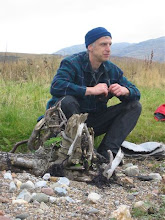 An hour standing on the edge of Flanders Moss at dusk at the end of a bitter winters day might not appeal to many but a small group of hardly souls gathered on Sunday for exactly that. We were out to count roosting hen harriers. Hen harriers are a bird of prey that is in trouble. They are persecuted in many places where they try to breed so their numbers across the country are much less than they should be. For this reason a lot of effort is put in to count their numbers both their nests on moorland in summer and their roost sites in winter. At this time of year these birds spend the day hunting alone for small birds and mammals, quartering low over rough vegetation listening and watching for the rustle and flutter of prey. But come evening they fly off to a traditional spot where groups of birds roost on the ground. And we are lucky that Flanders Moss is one of those places. There is a coordinated count of hen harrier roost sites across the country when every month at a set time hundreds of people set themselves up to watch an area and the totals give an idea of how many hen harriers are wintering in the UK.
An hour standing on the edge of Flanders Moss at dusk at the end of a bitter winters day might not appeal to many but a small group of hardly souls gathered on Sunday for exactly that. We were out to count roosting hen harriers. Hen harriers are a bird of prey that is in trouble. They are persecuted in many places where they try to breed so their numbers across the country are much less than they should be. For this reason a lot of effort is put in to count their numbers both their nests on moorland in summer and their roost sites in winter. At this time of year these birds spend the day hunting alone for small birds and mammals, quartering low over rough vegetation listening and watching for the rustle and flutter of prey. But come evening they fly off to a traditional spot where groups of birds roost on the ground. And we are lucky that Flanders Moss is one of those places. There is a coordinated count of hen harrier roost sites across the country when every month at a set time hundreds of people set themselves up to watch an area and the totals give an idea of how many hen harriers are wintering in the UK.So on Sunday with the temperature well below freezing, a skim of snow across the ground and a biting wind nipping across the moss we set off to the tower. My daughter Holly and I met up with Stephen, Betty and Tony and went up the tower to scan the bog surface. Peter and Darren from Thornhill walked out to the north east corner to get a view across the edge of the moss. At first their was a bit of chatter as people retained some heat from the cars. All experienced counters different people had different tactics to stay warm. Stephen drank huge amounts of tea and wore what looked like knitted wellingtons. Tony had what can only be described as a headdress on, Betty came with a banquet and Holly just talked a lot. A few members of the public drifted around the boardwalk for a quick Sunday constitutional while glancing at the fancy dress party on the tower. Our hour long watch went from half an hour before to half an hour after sunset and it quickly became apparent that it wasn't going to be much of a sunset. The light colour of the day just gradually seeped out of the day, someone was downing the lights very slowly. A couple of wrens traded churrs, a buzzard came off the surrounding fields trailing two jackdaws and a fieldfare or two chuck chucked overhead but no hen harriers. The peak time of sunset past and now few words were spoken as the cold sucked the heat out of us bringing down our core temperatures. And still no hen harriers. With 10 minutes to go Holly was starting to stamp her feet and mumbled about having no toes left but still no hen harriers. And then it was the end of the hour, Peter and Darren phoned from the other side to say that they had seen a merlin but no hen harriers and made our final scans. "Male" said Tony and amazingly in the half light he had picked up a male bird coming in very late, drifting through the scrub briefly and disappearing. Stephen saw it before it went but Betty, Holly and I all missed it. There was then a general stamping of feet, waggling of fingers and we wobbled back down on numb legs to try and get our circulation going on the way back to the car, leaving the tower black against the inky sky. One bird was better than no birds, but even our best count in the last eight years has been only four. Once back in the truck we had some chocolate and hot juice, put the heater on full blast and our faces went tight and itchy with the blood starting to move again. So for Holly and I we had an hour getting frost bite, hypothermia and not seeing any birds but it was still magic. Being able to watch a place like Flanders Moss close down for the night in winter gives a glimpse in the window of the everyday detailed goings on on this myterious and atmospheric bog. Sometimes you need a reason such as a hen harrier (non) count to make you get out and see it.




